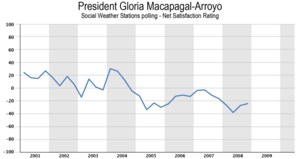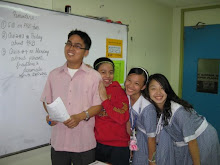
Early life
She was born as Maria Gloria Macaraeg Macapagal to politician Diosdado Macapagal and his wife, Evangelina Macaraeg-Macapagal. She is the sister of Dr. Diosdado "Boboy" Macapagal, Jr. & Cielo Macapagal-Salgado. She spent the first years of her life in Lubao, Pampanga with her two older siblings from her father's first marriage. At the age of four, she chose to live with her maternal grandmother in Iligan City. She stayed there for three years, then split her time between Mindanao and Manila until the age of 11. She is fluent in English, Tagalog, Spanish and several other Philippine languages, most importantly, Kapampangan, Ilokano (learned from her mother), and Cebuano (learned from living in Iligan City, Mindanao, where the language is the lingua franca).
In 1961, when Arroyo was just 14 years old, her father was elected as president. She moved with her family into Malacañang Palace in Manila. A municipality was named in her honor, Gloria, Oriental Mindoro. She attended Assumption Convent for her elementary and high school education, graduating valedictorian in 1964. Arroyo then studied for two years at Georgetown University's Walsh School of Foreign Service in Washington, D.C. where she was a classmate of future United States President Bill Clinton and achieved consistent Dean's list status.[6] She then earned her Bachelor of Arts degree in Economics from Assumption College, graduating magna cum laude in 1968. In 1968, Arroyo married lawyer and businessman Jose Miguel Arroyo of Binalbagan, Negros Occidental, whom she had met while still a teenager. They had three children, Juan Miguel (born 1969), Evangelina Lourdes (born 1971) and Diosdado Ignacio Jose Maria (born in 1974). She pursued a Master's Degree in Economics at the Ateneo de Manila University (1978) and a Doctorate Degree in Economics from the University of the Philippines (1985). From 1977 to 1987, she held teaching positions in several schools, notably the University of the Philippines and the Ateneo de Manila University. She became chairperson of the Economics Department at Assumption College. In 1987 she was invited by President Corazon Aquino to join the government as Assistant Secretary of the Department of Trade and Industry. She was promoted to Undersecretary two years later. In her concurrent position as Executive Director of the Garments and Textile Export Board, Arroyo oversaw the rapid growth of the garment industry in the late 1980s.
Senate
Arroyo entered politics in the 1992 election, running for senator. At the first general election under the 1987 Constitution, the top twelve vote-getting senatorial candidates would win a six-year term, and the next twelve candidates would win a three-year term. Arroyo ranked 13th in the elections, earning a three-year term. She was re-elected in 1995, topping the senatorial elections with nearly 16 million votes. As a legislator, Arroyo filed over 400 bills and authored or sponsored 55 laws during her tenure as senator, including the Anti-Sexual Harassment Law, the Indigenous People's Rights Law, and the Export Development Act. The 1995 Mining Act, which allows 100% foreign ownership of Philippine mines, has come under fire from left-wing political groups.
Vice Presidency
Arroyo considered a run for the presidency in the 1998 election, but was persuaded by President Fidel V. Ramos and leaders of the administration party Lakas-Christian Muslim Democrats to instead seek the vice-presidency as the running mate of its presidential candidate, House Speaker Jose de Venecia, Jr.Though the latter lost to popular former actor Joseph Ejercito Estrada, Arroyo won the vice presidency by a large margin, garnering more than twice the votes of her closest opponent, Estrada's running mate Senator Edgardo Angara. Arroyo began her term as Vice President on June 30, 1998. Historically, she was the first and only to date female Vice President of the Philippines. She was appointed by Estrada to a concurrent position in the cabinet as Secretary of Social Welfare and Development. Arroyo resigned from the cabinet in October 2000, distancing herself from President Estrada, who was accused of corruption by a former political supporter, Chavit Singson, Governor from Ilocos Sur. She had initially resisted pressure from allies to speak out against Estrada, but eventually joined calls for Estrada's resignation.
Presidency
First Term (2001-2004
Succession
Second Term (2004-present)
2004 Presidential Election rigging allegations
On June 30, 2004, in a break with tradition, Arroyo first delivered her inaugural speech at the Quirino Grandstand in Manila. She then departed for Cebu City for her oath taking, the first time that a Philippine president took the oath of office outside of Luzon.Allegations of cheating against Arroyo gained momentum one year after the May 2004 elections. In a press conference held on June 10, 2005, Samuel Ong, former deputy director of the National Bureau of Investigation (NBI) claimed to have audio recordings of wiretapped conversations between Arroyo and an official of the Commission on Elections (COMELEC). Virgilio Garcillano, a former COMELEC commissioner, would later be identified as the offical talking to Arroyo. According to Ong, the recordings allegedly proved that Arroyo ordered the rigging of the national elections for her to win by around one million votes against Poe. The recordings of Ong became known as the Hello Garci controversy and triggered massive protests against Arroyo. Key members of her cabinet resigned from their respective posts and urged Arroyo to do the same. On June 27, 2005, Arroyo admitted to inappropriately speaking to a COMELEC official, claiming it was a "lapse in judgement". She, however, denied influencing the outcome of the elections and declared that she won the elections fairly. Arroyo did not resign despite the pressures coming from various sectors of society. The Hello Garci controversy became the basis of the impeachment case filed against Arroyo in 2005. Attempts to impeach Arroyo failed later that year. Another impeachment case was filed against Arroyo in 2006 but was also defeated at the House of representatives. In October 2007, lawyer Alan Paguia filed an impeachment complaint against Arroyo in connection with the issue of bribery. Paguia's complaint was based on the revelation of Pampanga Gov. Ed Panlilio that various governors received half a million pesos from Malacañang. The impeachment case, as of the middle of October 2007, has already been referred to the House of Representatives Committee on Justice.
Charter Change
Arroyo currently spearheads a controversial plan for an overhaul of the constitution to transform the present unitary and presidential republic with a bicameral legislature into a federal parliamentary government with a unicameral legislature.[14]
Congressional bid in Pampanga
On November 30, 2009, after much speculation, President Arroyo announced on the Philippine Broadcasting Service her congressional bid for the second district of Pampanga.[15] On December 1, 2009, she filed her candidacy under the Lakas-Kampi-CMD.[16]
Economy
Domestic Policies
Foreign Policies
Main article: Presidency_of_Gloria_Macapagal-Arroyo#Foreign_PoliciesPublic perception
The Social Weather Stations public opinion group has conducted quarterly surveys tracking the net satisfaction rating ("satisfied" rating minus "dissatisfied" rating") of President Arroyo. She began her presidency in the first quarter of 2001 with a net satisfaction rating of +24. Her rating first dipped into the negative in the first quarter of 2003, making Arroyo the only president to achieve a negative net satisfaction rating in SWS opinion polling. Her rating rebounded well into the positive in 2004, in time for the presidential election where she won election to a new six-year term. However, net satisfaction sunk back into negative territory in the fourth quarter of 2004, and has remained negative since, dipping as low as -38 in the second quarter of 2008. Her net satisfaction rating in the first quarter of 2009 was -32.





No comments:
Post a Comment